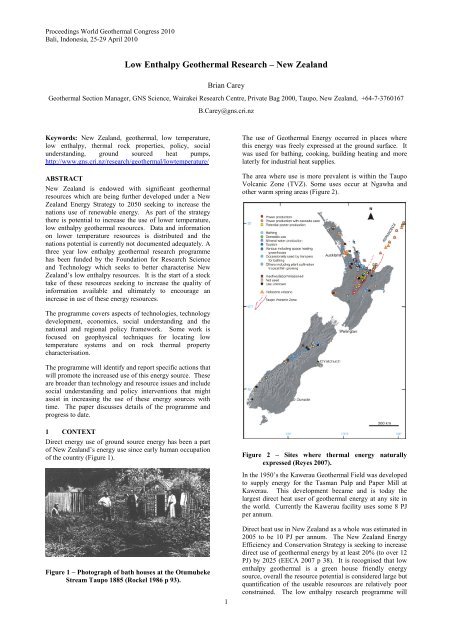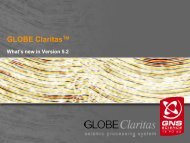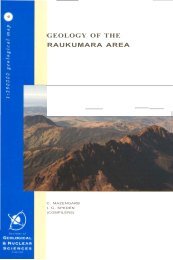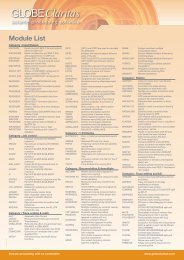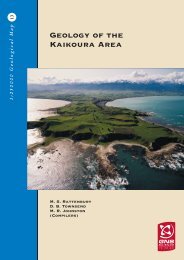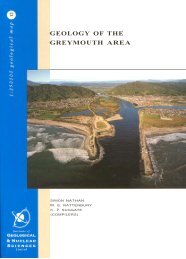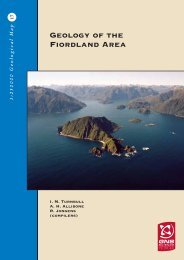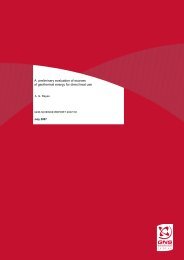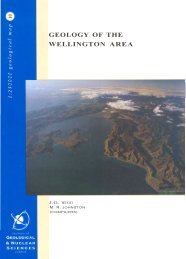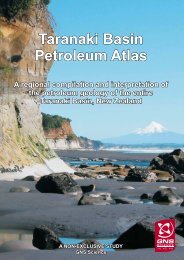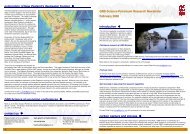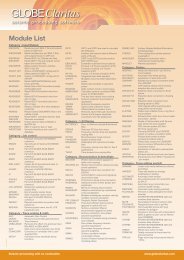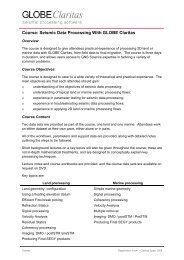Low Enthalpy Geothermal Research â New Zealand - GNS Science
Low Enthalpy Geothermal Research â New Zealand - GNS Science
Low Enthalpy Geothermal Research â New Zealand - GNS Science
You also want an ePaper? Increase the reach of your titles
YUMPU automatically turns print PDFs into web optimized ePapers that Google loves.
Proceedings World <strong>Geothermal</strong> Congress 2010Bali, Indonesia, 25-29 April 2010<strong>Low</strong> <strong>Enthalpy</strong> <strong>Geothermal</strong> <strong>Research</strong> – <strong>New</strong> <strong>Zealand</strong>Brian Carey<strong>Geothermal</strong> Section Manager, <strong>GNS</strong> <strong>Science</strong>, Wairakei <strong>Research</strong> Centre, Private Bag 2000, Taupo, <strong>New</strong> <strong>Zealand</strong>, +64-7-3760167B.Carey@gns.cri.nzKeywords: <strong>New</strong> <strong>Zealand</strong>, geothermal, low temperature,low enthalpy, thermal rock properties, policy, socialunderstanding, ground sourced heat pumps,http://www.gns.cri.nz/research/geothermal/lowtemperature/ABSTRACT<strong>New</strong> <strong>Zealand</strong> is endowed with significant geothermalresources which are being further developed under a <strong>New</strong><strong>Zealand</strong> Energy Strategy to 2050 seeking to increase thenations use of renewable energy. As part of the strategythere is potential to increase the use of lower temperature,low enthalpy geothermal resources. Data and informationon lower temperature resources is distributed and thenations potential is currently not documented adequately. Athree year low enthalpy geothermal research programmehas been funded by the Foundation for <strong>Research</strong> <strong>Science</strong>and Technology which seeks to better characterise <strong>New</strong><strong>Zealand</strong>’s low enthalpy resources. It is the start of a stocktake of these resources seeking to increase the quality ofinformation available and ultimately to encourage anincrease in use of these energy resources.The use of <strong>Geothermal</strong> Energy occurred in places wherethis energy was freely expressed at the ground surface. Itwas used for bathing, cooking, building heating and morelaterly for industrial heat supplies.The area where use is more prevalent is within the TaupoVolcanic Zone (TVZ). Some uses occur at Ngawha andother warm spring areas (Figure 2).The programme covers aspects of technologies, technologydevelopment, economics, social understanding and thenational and regional policy framework. Some work isfocused on geophysical techniques for locating lowtemperature systems and on rock thermal propertycharacterisation.The programme will identify and report specific actions thatwill promote the increased use of this energy source. Theseare broader than technology and resource issues and includesocial understanding and policy interventions that mightassist in increasing the use of these energy sources withtime. The paper discusses details of the programme andprogress to date.1 CONTEXTDirect energy use of ground source energy has been a partof <strong>New</strong> <strong>Zealand</strong>’s energy use since early human occupationof the country (Figure 1).Figure 1 – Photograph of bath houses at the OtumuhekeStream Taupo 1885 (Rockel 1986 p 93).1Figure 2 – Sites where thermal energy naturallyexpressed (Reyes 2007).In the 1950’s the Kawerau <strong>Geothermal</strong> Field was developedto supply energy for the Tasman Pulp and Paper Mill atKawerau. This development became and is today thelargest direct heat user of geothermal energy at any site inthe world. Currently the Kawerau facility uses some 8 PJper annum.Direct heat use in <strong>New</strong> <strong>Zealand</strong> as a whole was estimated in2005 to be 10 PJ per annum. The <strong>New</strong> <strong>Zealand</strong> EnergyEfficiency and Conservation Strategy is seeking to increasedirect use of geothermal energy by at least 20% (to over 12PJ) by 2025 (EECA 2007 p 38). It is recognised that lowenthalpy geothermal is a green house friendly energysource, overall the resource potential is considered large butquantification of the useable resources are relatively poorconstrained. The low enthalpy research programme will
Careyseek to provide a sound platform from which the increase indirect heat utilization can be built off.Questions posed concerning <strong>New</strong> <strong>Zealand</strong>’s low enthalpygeothermal resources are:• what is the extent of the resources ?• what is their sustainable capacity ?• what are the available technologies for energyextraction, are they appropriate ?• Where are the demands for energy and heat thatmight be able to be supplied from these resources ?• what technology needs to be developed ?• What are the impediments, such as socio-economic,policy, or Maori-specific barriers, that currentlylimit use of low enthalpy sources, and how mightthese barriers be removed ?Part of the answer to these questions will come fromgeoscientific, engineering, social, economic and policystudies funded as part of the 3 year Foundation for <strong>Research</strong><strong>Science</strong> and Technology (FRST) research programmerunning from 2008 to 2011.The one intermediate outcome programme has beenstructured with four objectives:• National Review• Resource Characterisation• Technology & Tool Development• Integrated AssessmentSeveral key outcomes will result from this study:• A quantitative review and assessment of lowenthalpy resources and technologies identifyingresearch gaps.• Improved tools and methods for resourceassessment.• Identification of knowledge gaps, including,resource information and exploration techniques.• Recommended actions for increasing utilisation oflow enthalpy resources,• The development of web based access to data,maps, research reports and models.2 BACKGROUND RESEARCH<strong>Low</strong> enthalpy research had previously been undertaken aspart of the FRST contracted Enhanced <strong>Geothermal</strong> Energyfor the <strong>New</strong> Millennium C05X0201 research programmeundertaken from 2002 to 2007.Various research had been completed as part of thatprogramme. Papers had been prepared by White, Thain andReyes. Those readily accessible have been assembled in thereference list at the end of the paper.<strong>Low</strong> enthalpy research was not funding under the FRSTcontracted <strong>Geothermal</strong> <strong>New</strong> <strong>Zealand</strong>'s Energy SolutionC05X0704 research programme for the period 2007 to 2013instead a focused 3 year low enthalpy programmeC05X0710 was contracted to <strong>GNS</strong> <strong>Science</strong> in 2008.3 NATIONAL STOCK TAKEA stock take of the available resource information,technologies, demand, economics, social understanding andpolicy framework for the use of low enthalpy resources in<strong>New</strong> <strong>Zealand</strong> will be undertaken seeking to identify specificknowledge gaps which will then be used to assist infocusing future work.Published science and industry-sourced data, policy andplanning documents will be reviewed. Preliminary fieldvisits, surveys and hui to gather new information will beundertaken.A technology review will examine technologies that areappropriate for use of low enthalpy sources, determine theirstatus as; ready for use, research, or under development anddetermine technology applicability with source and usetemperature ranges.Demand characterisation will better identify the specificareas that low enthalpy energy solutions might bestcontribute.Barriers to uptake will be identified through a review ofcurrent policies and economics, as well as elucidating thecurrent public understanding of technologies and availableresources. Statistically robust state of knowledge surveys ofprivate and commercial entities in selected areas areproposed.Māori traditional knowledge pertaining to low temperaturegeothermal resources will be researched.Review and assessment activities will consider internationaltrends with a particular focus on nations where lowenthalpy resource uptake has been accelerating in recentyears, for example the US, Hungary, Iceland and Germany.This will provide an understanding of the social and policyenvironment within which this acceleration occurred and itspossible relevance to the <strong>New</strong> <strong>Zealand</strong> context.The stock take will focus on existing knowledge seeking toidentify gaps. An information prioritisation process basedon likely use (and demand) will be developed to informselection of areas for further study.The outputs will be reviewed by a technical panel,comprising members from crown research institutes,government agencies and industry collaborators.4 RESOURCE CHARACTERISATIONBetter understanding requires improved delineation andassessment of resource quality and quantity.This work will identify the low enthalpy energy resourcesassociated with some of <strong>New</strong> <strong>Zealand</strong>’s thermal waters;including springs and borehole fluid discharges, energyavailable in shallow groundwater aquifers, warm watersassociated with abandoned oil and gas wells, and floodedunderground coal and mineral mines.2
CareyAssessment will be undertaken:• at 4 sites on the margins of high temperaturegeothermal systems including Tauhara, Mokai,Rotorua and Ngawha;• at 12 thermal water discharge sites outside of theTaupo Volcanic Zone and Ngawha;• selected onshore abandoned hydrocarbon wells;• at selected underground mines;• at selected industrial sites assessing low enthalpyexhaust sources.Data from shallow and deep wells, and heat flow studieswill be used to assist in developing an improved surfaceconductive heat flow map of NZ. Temperatures at shallowdepths will be estimated and correlated to regional and localgeological and hydrogeological conditions.Two low temperature mathematical modelling case studiesof Tauranga and Whitford at Auckland will be preparedseeking to identify the longer term sustainable energy yieldfrom these low enthalpy resources.5 METHODOLOGIES FOR IDENTIFICATION5.1 Tool DevelopmentThe focus of this is to refine techniques and tools whichmight assist in accelerating identification of low enthalpyresources there by assisting increased uptake of lowenthalpy resources use in <strong>New</strong> <strong>Zealand</strong>.Various geophysical methods and combinations ofmethods, including resistivity, electromagnetic andsiesmoelectric, will be trialed and assessed for theireffectiveness in locating structure and faults that mightpreferentially channel warm water to the surface. Thesemethods will be used to map shape, size, and depth ofgeological structures seeking to identify the presence oflow-enthalpy resources at up to three sites in differentsettings across <strong>New</strong> <strong>Zealand</strong>.Field and laboratory measurements of thermal rockproperties will be undertaken. Temperatures at shallowerdepths will be evaluated and correlated with the regionaland local geological and hydrogeological conditions. Fourstandard temperature calibration holes will be set up inselected parts of <strong>New</strong> <strong>Zealand</strong> looking to characteriseseasonal phase lag in ground temperatures with depth downto about 10m. Rock property characterisation will seek toprovide increased use of ground heat sources by improvingavailable heat transfer data for ground source heat pumptechnology. Laboratory and field testing will be conductedto better characterise a selected range of near surface soiland rock formations determining their heat transfercharacteristics, thermal conductivity and specific heatcapacity. Measurements will also be undertaken to enablerock heat transfer characteristics to be established forground source heat pump loop sizing for <strong>New</strong> <strong>Zealand</strong>conditions. This will be focused on anticipated locationswhere the installation of ground sourced heat pumps mightoccur.5.2 TechnologiesIdentifying of technologies that are appropriate for use withlow enthalpy sources will identify their status as;• ready for use,• under commercial development, or• further research required,Ground Source Heat Pump case studies will be developedfrom Swedish and Germany experience providing insightinto the embracing of this technology in those nations.Other case studies will include a hydrocarbon wellconversion study, a small scale binary cycle geothermalelectricity generation plant study and a direct heat use studyusing heat discharged from an industrial process.Recommendations will be made as to the areas oftechnology that hold the most promise and a strategy willbe developed for emerging technologies.6 INTEGRATED ASSESSMENTInformation and data collected as part of the programmewill be summarized into an integrated assessment andreview that will be prepared in the final few months of theprogramme. The review will summarise findings from thework including:• low enthalpy resource information collected aspart of the work• low enthalpy demand characterisation• Discussion on the appropriate technologies andthe technology strategy• Simple economic models (costs and benefits) forvarious types of resources and technologies• Identification of areas where further study wouldbe beneficialThe data will be worked into a ranking hierarchy to assist inprioritisation to achieve the most beneficial outcomes fromlow enthalpy resource utilization. Policy enhancements thatmight further encourage use of low enthalpy energy sourcesin <strong>New</strong> <strong>Zealand</strong>, and increase social acceptance, includingaddressing Māori specific needs will be identified.Recommendations on steps to be taken to further enhancethe uptake of low enthalpy energy use will be identified.7 INFORMATIONResource assessment data is being assembled in a GISreferenced database which will enable easy addition offuture data as it is collected.Reports and other data collected will be disseminated and alow enthalpy web site has been set up for that purpose.This will become the focus of information disseminationand possibly a forum for discussion on low enthalpytechnology and issues.To visit the web site use this URLhttp://www.gns.cri.nz/research/geothermal/lowtemperature/If you would like to contribute ideas or have material thatyou consider might be useful to the low enthalpyprogramme then please email your views togeothermal@gns.cri.nz .3
Carey8 PROGRAMME MANAGEMENTThe research programme is led by Brian Carey <strong>Geothermal</strong>Section Manager at <strong>GNS</strong> <strong>Science</strong>. A multidisciplinary teamof <strong>GNS</strong> scientists are involved in the programme. CitoGazo an energy research engineer from Coal <strong>Research</strong> Ltdis involved in technology aspects of the programme andMike O’Sullivan University of Auckland is supervisingstudents performing resource modeling case studies.9 PROGRESS TO DATEThe work programme is in the early phases of datagathering which will intensify over the coming year. Theoutputs from some of the data gathering along with earlyinterpretation and opinions will be presented at WGC 2010.10 OUTCOMESThe programme seeks to support further utilisation of lowenthalpy geothermal resources in <strong>New</strong> <strong>Zealand</strong>. Targetinga 20% increase on the 2005 direct heat utilisation level of10 PJ / year increasing that to 12 PJ / year by 2025. It isconsidered that societal expectation and policy will have asmuch to contribute to realising this target as willappropriate economic technologies.11 ACKNOWLEDGEMENTThe Foundation for <strong>Research</strong> <strong>Science</strong> and Technology isacknowledged for providing the funding for this lowenthalpy research programme and for the preparation andpublication of this paper.REFERENCESEECA, October 2007. <strong>New</strong> <strong>Zealand</strong> Energy Efficiency andConservation Strategy. <strong>New</strong> <strong>Zealand</strong> Government.84p. ISBN 978-0-478-19503-3 (PDF).Reyes, A.G. 2006. Unconventional sources of geothermalenergy in <strong>New</strong> <strong>Zealand</strong>. Proceedings 28th NZ<strong>Geothermal</strong> Workshop. November 2003, Auckland.8p.Reyes, A. and Jongens, R. 2005. Tectonic settings of lowenthalpy geothermal systems in <strong>New</strong> <strong>Zealand</strong>: anoverview. Proceedings World <strong>Geothermal</strong> Congress,April 2005, Antalya, Turkey. pp24-29.Reyes, A.G. 2007. A preliminary evaluation of sources ofgeothermal energy for direct heat use. <strong>GNS</strong> <strong>Science</strong>Report 2007/16. 37p. ISSN 1177-2425.Reyes, A.G. 2007 Characteristics and Distribution ofMineral Waters for <strong>Geothermal</strong> Use, <strong>New</strong> <strong>Zealand</strong>.Poster NERI Conference November 2007 Auckland<strong>New</strong> <strong>Zealand</strong>.Thain, I., Reyes, A.G. and Hunt, T. 2006. A practical guideto exploiting low temperature geothermal resources.<strong>GNS</strong> <strong>Science</strong> Report 2006/09. June 2006. 76p. ISSN1171-2425.White, B. July 2006. An assessment of geothermal directheat use in <strong>New</strong> <strong>Zealand</strong>. <strong>New</strong> <strong>Zealand</strong> <strong>Geothermal</strong>Association Inc, 30p.4


